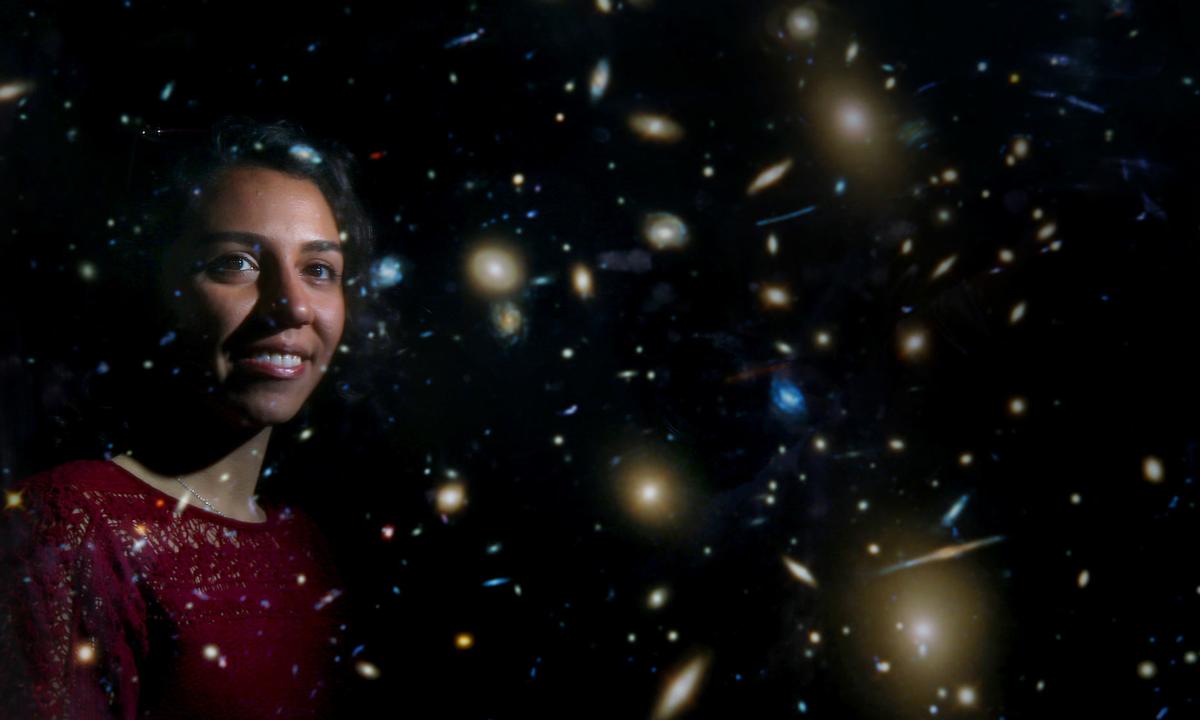NASA has three big questions it is trying to answer: How does the universe work? How did we get here? And are we alone?
Irene Shivaei is working on answers as a NASA Hubble Fellow. A postdoctoral research associate in George Rieke’s lab at the University of Arizona, she’s part of the James Webb Space Telescope team, studying dust in space and star formations to figure out the origin of our galaxies.
She focuses on galaxies that are 3 billion years old, because that’s when star and galaxy formation activity is at its peak. Using infrared technology, she uses the long wavelengths of light that the dust particles emit to study the properties and characteristics of dust.
“It’s an important era to study the properties of galaxies, how they evolve, how they become galaxies that we have today, like the Milky Way or other nearby galaxies,” Shivaei said.
The Webb telescope is the next frontier of astronomy, according to Shivaei, because it will allow astronomers to observe wavelengths of light they weren’t able to see with much accuracy before.
“It will revolutionize the field,” Shivaei said. “It will open up this whole new parameter space of looking at our universe.”
Rieke said the team plans to use the Webb telescope to do a very detailed map “of the most studied little post stamp of the sky,” the Hubble Ultra Deep Field.
One result of that map will be the ability to determine definitely how many stars are forming, because with current technology almost half of star formation is hidden by dust, Rieke said. They’ll also be able to see that dust more clearly, which is Shivaei’s specialty.
But Shivaei’s vision isn’t always set to the stars.
Here on Earth, she’s involved in science outreach and is also the co-chair of a conference on dust being held at the UA March 4 through March 8.
The conference, called Dusting the Universe, will focus on the composition, physical nature and evolution of dust in space, both what has been observed and theorized.
“It’s a lot of work. It’s crazy, but I’m excited to see it and listen to all the amazing talks,” Shivaei said.
The conference took months of planning, according to co-chair Stacey Alberts, a senior research associate of the Webb telescope, and they read more than 100 of the submitted abstracts before choosing who would present.
“One of the things we wanted to do was talk to people we don’t normally talk to,” Alberts said.
“In science, you end up in your own little niche area and you have your topic. You know it really well and you (only) talk to the other people who know it really well, but ... you have the big picture, so we wanted to have people we don’t always talk to.”
Beyond just reaching out to different parts of the scientific community, Shivaei also works to share her love of astronomy and science with the community.
When she came to Tucson, she started a mentorship program for high school students at the Ha:san Preparatory and Leadership School that mostly serves Tohono O’odham students. Once a week, UA undergraduates go to the school and tutor students in math.
“The reason we went to the school is a lot of our telescopes on Kitt Peak are on the reservation, so that was the connection between us and the community,” Shivaei said.
While Shivaei said she originally planned on running an astronomy club, the Ha:san principal told her the students needed help with math, so Shivaei decided to change the direction of her program to better meet the students’ needs.
“It’s very rewarding. I love it and I think the school also really likes it, the principal is really happy with the program and I think it has a high impact for students.”
Born and reared in Tehran, Iran, Shivaei also runs a website called Staryab, which translates astronomy articles and papers not just into a more understandable format for young astronomers, but into Persian as well.
“I always liked outreach stuff, parallel to my research,” Shivaei said. “I always spend time on outreach because it’s very important to share your discoveries and your knowledge with the public, and I think the whole society benefits from it.”
Shivaei also contributes to the lab, according to Rieke, because she’s always coming up with new ideas and likes to challenge herself.
“She’s very interactive, upbeat, has good ideas and everybody likes everybody else,” Rieke said.
“It’s that sort of spirit, and it’s in that spirit that I think the best science is done.”
Alberts, who works on the mid-infrared instrument with Shivaei, agreed she blends well with the research group. Alberts has been working on the Webb telescope since 2014.
“We were really excited to bring her on,” Alberts said.
“It’s been two years and she just fits right into the group. And of course, she brings a different expertise, which is what George was looking for.”
For Shivaei, the chance to work on the Webb telescope as a Hubble Fellow started as a distant dream, and the result left her “happy and honored.” She started the three-year fellowship in September 2018.
“We had speakers coming or I knew people from conferences, different places, who had a Hubble fellowship and I was like, ‘Wow, these are really smart people,’” Shivaei said.
“I honestly never thought that I would be on that stage. I loved what I was doing and I just did it. I think it paid off.”





